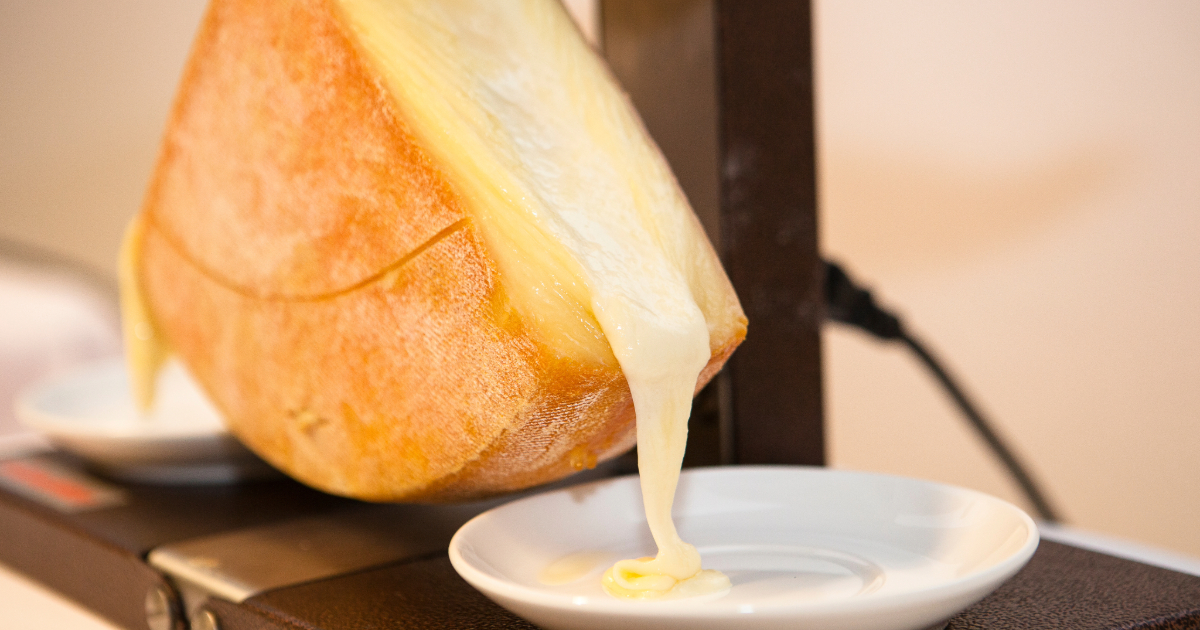Raclette cheese is a delicious semi-hard cow's milk cheese originally from Switzerland. It is famous for its use in the dish also called raclette, where it is melted and scraped over boiled potatoes, pickles, cured meats and vegetables.

However, authentic raclette cheese can be difficult to find and expensive to buy outside of Europe. Luckily, there are several excellent substitutes that can mimic both the flavor and melting properties of raclette.
What is Raclette Cheese?
Raclette cheese is a semi-hard cheese made from cow's milk in the Alpine regions of Switzerland. The cheese has a smooth, creamy texture and a mild, nutty flavor.
Traditionally, raclette cheese is formed into a large wheel and heated in front of an open fire. As the wheel warms, the surface softens and melts. This melted cheese is then scraped ("raclé" in French) off onto boiled potatoes, pickles and cured meats.
Raclette's excellent melting properties come from its semi-hard consistency and the use of cow's milk from Alpine pastures. The cows graze on sweet mountain grasses in the summer and are fed hay in winter. This diet contributes to the signature mild, subtly sweet flavor of raclette cheese.
The cheese is aged a minimum of 3 months, but it can be aged for over a year. Young raclette has a very mild flavor, while longer aging gives it a stronger, more pungent taste and aroma.
Why Use a Raclette Cheese Substitute?
There are a few reasons you may need a good raclette cheese alternative:
- Authentic raclette cheese can be hard to find outside of Europe, as production is limited mainly to Switzerland and parts of France.
- Imported raclette cheese can be expensive, especially when buying a whole wheel. Larger pieces are required for the traditional melting technique.
- You may want to experiment with different flavors and textures while still achieving the melted, "scrapeable" consistency of raclette.
- You may have an allergy or sensitivity to cow's milk and need a non-dairy sub. Some goat or sheep's milk cheeses can work well.
9 Best Substitutes for Raclette Cheese
If you can't get your hands on real raclette cheese, don't worry! Here are 9 excellent substitutes to consider for your melted cheese needs:
1. Gruyère
Gruyère is widely considered to be the best raclette cheese substitute. Like raclette, it's a Swiss cow's milk cheese with a creamy, smooth texture when melted.
Opt for a young Gruyère aged 6-9 months to get a mild, nutty flavor close to raclette. The taste gets stronger with more aging. Gruyère melts beautifully and is commonly used in fondue as well.
It's easier to find than raclette, and comes in smaller wedges ideal for home use. Replace raclette 1:1 with Gruyère in any recipe.
2. Appenzeller
Appenzeller is a semi-hard Swiss cheese with a flavor profile similar to raclette - nutty, fruity and herbal. Though the taste is stronger than raclette, a young 3-4 month Appenzeller makes an excellent substitute.
It has good meltability despite its firm texture. For recipes using raclette as an ingredient, use about 3/4 as much Appenzeller to account for its more robust flavor. It stands up well in cheese fondue blends.
3. Emmental
Emmental is a medium-hard Swiss cheese with a sweet, nutty taste much like raclette. Its distinctive holes ("eyes") come from gases released during aging.
Emmental doesn't get quite as smooth and creamy when melted. However, its flavor works well in fondues, gratins, quiches and other recipes requiring melted cheese. Use a 1:1 ratio when substituting.
4. Fontina
Fontina is an Italian semi-hard cow's milk cheese with excellent melting properties. It has a creamy texture and mild flavor with nutty, buttery notes.
Fontina melts smoothly with a rich taste. Use 3/4 to 1 part Fontina per 1 part raclette called for, as Fontina has a more robust flavor. It works well in many baked pasta and vegetable dishes.
5. Asiago
Asiago is an Italian semi-hard cheese that can be used similarly to raclette for melting. Nutty and slightly tangy when young, its flavor gets quite sharp with age.
For raclette recipes, use younger Asiago for the mildest taste. Asiago Pressato is a good choice. Replace raclette 1:1 with Asiago, adjusting if you prefer a sharper cheese flavor.
6. Gouda
Gouda is a widely available Dutch cheese that shares some similarities with raclette. Softer, younger goudas (aged one month) have a mild, lightly sweet flavor and creamy texture.
Aged gouda can work as well, though the taste gets more robust. The buttery, tangy notes of an aged gouda pair nicely when melted in some dishes. Use a 1:1 ratio when substituting.
7. Cheddar
Aged cheddar, especially white cheddar, is an accessible option for melting instead of raclette. It becomes smooth and creamy when melted while providing a nutty, tangy flavor.
Cheddar tastes different than raclette, but melts nicely for dishes like cheese sauces. Use a medium or sharp cheddar, and replace raclette 1:1. Mild cheddar lacks the distinctive aged flavor.
8. Monterey Jack
Monterey Jack or "Jack" cheese makes for an easy raclette cheese alternative. Jack has a very mild flavor and melts smoothly, similar to young raclette.
It lacks the complex nutty, sweet flavors of raclette but provides excellent melting properties. Use Monterey Jack anywhere you want a mild, creamy melted cheese experience. Replace raclette 1:1.
9. Manchego
Manchego is a sheep's milk cheese from Spain that can melt well. It has a firm texture with a tangy, fruity taste that's quite different from raclette.
The flavor pairs wonderfully when melted over meat or vegetables. Replace raclette with an equal amount of manchego by weight. Pick manchego if you want a non-cow dairy alternative.
Key Takeaway: Gruyère, Emmental, Fontina, Gouda and Asiago are excellent substitutes to replicate both the flavor and texture of melted raclette cheese.
Tips for Melting Raclette Cheese Substitutes
To get an authentic raclette experience with any substitute cheese:
- Choose younger, creamier cheeses for melting. More aged cheeses can be crumbly or too strong-flavored.
- Cut cheese into thinner slices or small cubes to melt quickly and evenly. Grated cheese works too.
- Melt cheese slowly over low heat. High heat can make cheese tough or separate.
- Stir melted cheese frequently so it melts cohesively instead of clumping.
- Add a bit of milk or cream to the melted cheese to thin it out to raclette's creamy, silky texture.
- Try using a raclette machine, if you have one! Heat lamps or a broiler also work for melting.
- Serve your melted cheese substitute immediately over hot potatoes, bread, vegetables, cured meats or anything else that sounds good!
FAQs
Can I use mozzarella instead of raclette?
Mozzarella doesn't make the best sub for raclette. While it melts well, it has more elasticity and less richness than raclette when melted. Opt for fontina or gouda instead.
Is halloumi a good raclette alternative?
Halloumi won't work as a raclette substitute, unfortunately! Halloumi maintains its shape and doesn't properly melt when heated.
Can I use a raclette alternative if I'm lactose intolerant?
Yes, some lactose-free options like aged cheddar or Swiss cheese can mimic raclette well. For non-dairy, try melting nut-based cheese products.
What's the best way to melt cheese for serving raclette-style?
Use a raclette machine or oven broiler to melt slices evenly. You can then scrape the melted cheese off and serve immediately over warm potatoes, meat, veggies, etc.
Can I use pre-shredded cheese instead of block cheese?
Pre-shredded cheese often has additives to prevent clumping. This can prevent smooth melting. Buy cheese in blocks and shred or slice it yourself.
Conclusion
Raclette cheese is delicious, but can be hard to source and expensive. Luckily, there are many excellent cheese substitutes to give you the classic melted raclette experience.
With options like Gruyère, Emmental, Fontina, Asiago, Gouda and Cheddar, you can duplicate raclette's creamy melting texture and mild, nutty flavor profile.

